
This essay presents the timeline from the first to the last portable analog wireline local battery field telephones in use by the Swiss Army. (Pictures are from instruments in my collection.)
The Swiss Army Signalcorps (Telegraphentruppe) was established in 1875. Portable telephones were first introduced in 1888, a sound powered model by Hasler (only 18 pcs.) and a battery powered by Favarger (60 pcs.) which was only used in fortresses (so not really a "field" telephone). The first instrument which matches "our definition" is the Hasler made field telephone Ordonnanz 05 from 1905 (60 pcs.) which I call here "Generation 0" (and which is not part of my collection) [21].
As we will see, for the next 100 years, field telephones for the Swiss army were nearly exclusively developed by Siemens (With exception of the Art Tf "modular" by Hasler and the F Tf 41/47 by Autophon but both are basically just very minor adaptions of Siemens Designs, then in the 90ies the Swiss Eurocom D/1 implementation IMFS was provided through Ascom (ex. Hasler/Zellweger/Autophon/Gfeller), but was basically a British Plessey system, and Plessey was Siemens owned since 1989).
The first Swiss field telephone sourced in significant quantities was the Feldtelephon (As it was the first and only back then no further naming details, abbreviated FTf) which was developed and manufactured by Siemens & Halske (Germany). It was first introduced in 1909 and updated versions were introduced in 1924 and 1925 (2 pole switching plugs instead of the 1 pole plug rail, integrated magneto). About 1800 FTf (of all iterations) were acquired until 1930 [22]. It was retired and replaced by the ATf 32 and FTf 41 during the early 40ies (WWII).
In the picture below on the left an FTf (1909) and to the right a FTf Modell 1925.

The Swiss Army field phone Central Telephon (C-Tf) was first introduced in 1913 (or maybe an early version already in 1909 [21]). Originally designed and built by Siemens & Halske, Berlin the Central Telephon was later (1918) built in Switzerland by Telefonwerke Albisrieden (The Swiss Siemens subsidiary) and Hasler. Hasler delivered also a locally built Central Telephon Modell 1925. All in all there were about 900 pieces of the C-Tf [22]. The C-Tf. is still mentioned in the regulations of 1941 [3]. During WWII the instruments were retired and replaced by the ATf 32.
In the picture below from the left: a CTf (1918), a CTf Modell 1925 and a CTf (1913).
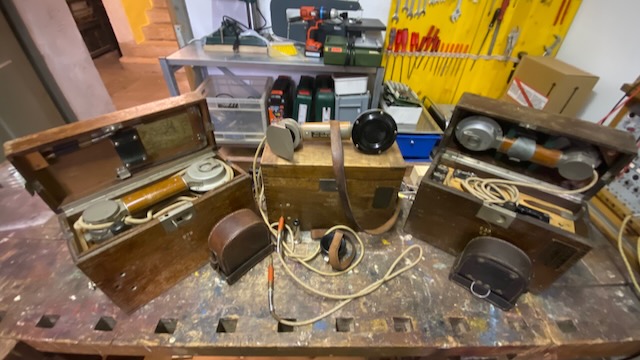
The Swiss Army Artillerie Telephon was developed by Siemens & Halske in 1913. From 1915 to 1917 about 1500 pcs. were delivered to the Swiss field artillery forces. At the same time about 500 of the Zerlegbares Telephon (Take-apart Telephone) version made by Hasler were acquired. The instrument is still mentioned in the regulations of 1941. During WWII the instruments were retired and replaced by the ATf 32.
In the picture below on the left a "modular" ArtTf (Hasler) and on the right a normal ArtTf (Siemens).
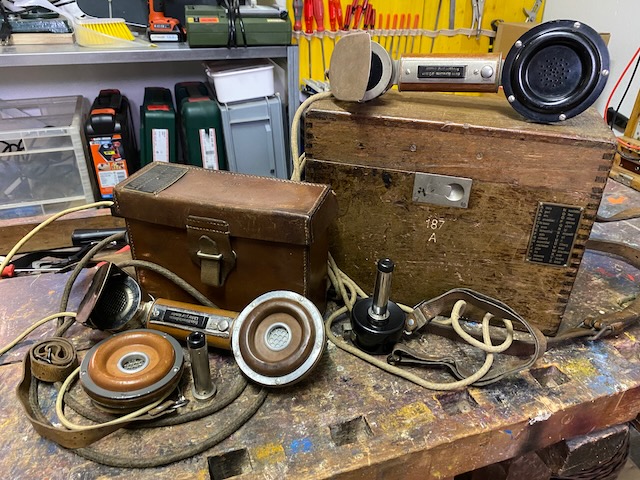
All 1st generation instruments were refurbished when repaired in the early 20ies and in general in 1935. During the 20ies for the F Tf and C-Tf the buzzers were updated to the Telephonwerke Albisrieden provided "Albis Buzzer" or the Hasler provided "English Buzzer", and the F Tf got a magneto added. The general refurbishment in ~1935 included all three, the FTf, C-Tf and ArtTF. It included capacitor replacement, replacement of carbon lightning arrestors with inert gas lightning arrestors, and the handsets and headsets were updated to use a PTT standard 1931 RX capsule and a more modern Siemens provided TX capsule [21] [22].
In the picture below on the left the original handset and headset setup (from a "modular" Art Tf), on the right the 1935 updated (from a C-Tf).

All initial 1st generation instruments were introduced with an open constructed Siemens type buzzer as main signalling device. The C-Tf already then had a magneto for AC signalling included, for the FTf this was added later, whereas the ArtTf never got a magneto and always only provided buzzer signalling. Later updated versions of the instruments were delivered with the "Albis Buzzer" (Telephonwerke Albisrieden) or the "English Buzzer" (Hasler), and often older instruments were updated with these when repaired/refurbished. The "Albis Buzzer" is a fully closed construction (with a lead seal) not intended to be field maintained (a single buzzer frequency adjusting bolt is accessible when not opened). This is the same buzzer later used in the ATf 32, the FTf 41 and the PiZen 37. The "English Buzzer" from Hasler is based on an english design with two adjusting bolts, comparable to the "Buzzer T.Mk.I.". The Albis and the English Buzzer also combined the buzzer coils with the voice coils.
In the picture below on the left an early C-Tf with Siemens Buzzer, in the middle a C-Tf with an English Buzzer, in front of it an opened Albis Buzzer and in the Background a C-Tf with an Albis Buzzer.
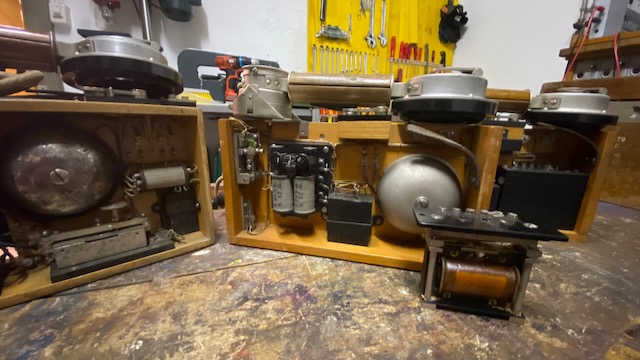
The Armeetelephon Modell 1932 (ATf 32) was developed by Telephonwerke Albisrieden A.G., Zürich (The Swiss Siemens subsidiary), in the early 30ies. It could replace the old C-Tf and the ArtTf and added the option to connect directly also to dial networks with an additional dial box. The first batch of about 1000 instruments was painted green/grey (body and wooden box), on the later models the body was painted black and the oak box clear-coat painted. Until 1946 total ~12k were delivered [21] [22].
By 1947 an only slightly updated, nearly identical version was introduced, the ATf 47, again developed by "Swiss Siemens" which was now called Albiswerk Zürich A.G. The major difference was that the Albis buzzer was left out and instead an anti-sidetone circuit voice coil was built in. Until 1950 total ~4k were delivered [21] [22].
In the picture below from left to right: A closed ATf 47, a 2nd generation ATf 32 with dial box and a first generation green ATf 32.
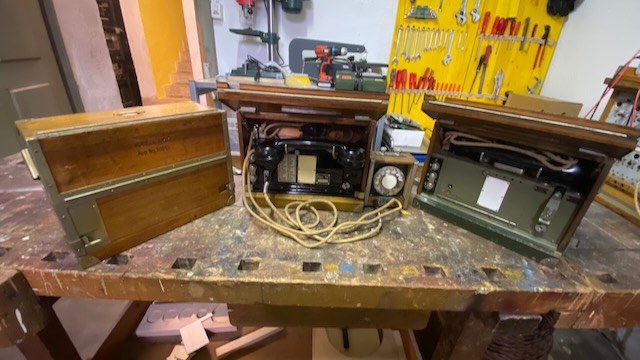
The Feldtelephon Modell 1941 (FTf 41) was developed by Autophon AG (based on the ATf 32 Telephonwerke Albisrieden design) as replacement for the 1st generation original FTf and FTf 1925. There were two slightly different series. Electrically and feature wise they were identical, but on the later series the mechanical construction of the lid support was improved significantly. Until 1946 total ~900 were delivered [21] [22].
By 1947 an only slightly updated, nearly identical version was introduced, the FTf 47. The major difference was that the Albis buzzer was left out and instead an anti-sidetone circuit voice coil was built in. Until 1950 total ~500 were delivered [21] [22].
In the picture below from left to right: FTf 47, a closed 2nd generation FTf 41 and a first generation FTf 41 ready to use.
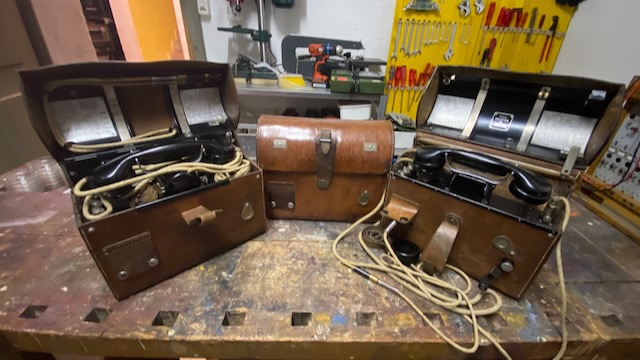
The Modell 47 handsets were already designed to take up Swiss PTT type 1946 RX and TX elements whereas the Modeel 31/41 handsets used Swiss PTT type 1931 sized elements. Later the Modell 32/41 handsets were updated with adapter rings on the TX side to take the 1946 size elements.
After WWII the Swiss Army purchased a bunch of U.S surplus SCR-399 radio sets which included some EE-8 for remote control usage of the sets [15] [34]. Improving on the EE-8 ideas Albiswerk developed then the Feldtelephon Modell 1950 (FTf 50). With 2.6kg (5.7lb) this instrument was very lightweight for it's time. Albiswerk delivered about 10k pieces to the Swiss Army between 1950 and 1960. Another about 3k pieces were delivered by Gfeller in the 60ies [21] [22]. The instrument was also delivered to the Swiss Civil Protection Service and to the Dutch army as "Veldtelefoontoestel TA-3001". Apart from the standard version with a single handset several FTf 50 versions with different special headsets exist [24].
Based on the FTf 50 electrical design a little bit later the Armeetelephon Modell 1953 (ATf 53, initially called TTf 53, for "Table telephone") was introduced as a more "indoors" type of instrument. It was again developed by Albiswerk but later also produced by Gfeller. A total of about 10k pieces were delivered [21] [22]. Additionally a dial unit for the ATf 53 was introduced, the unit was also compatible with the FTf 50.
In the picture below on the left an ATf 53 with dial unit and behind it a FTf 50.
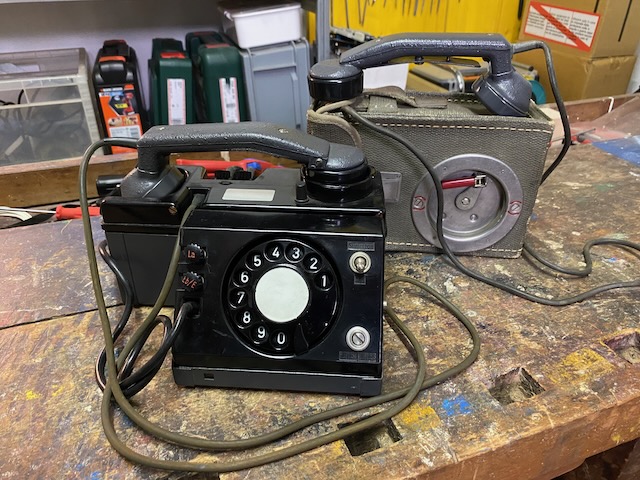
In the early 80ies the until then carbon based TX elements were replaced with dynamic elements.
The F Tf 50 and A Tf 53 were the last analog LB field telephones introduced in the Swiss army, some of them are probably still in active use. In 1996 the already digital (proprietary) Feldtelefon 96 (FTf 96, Awitel by Siemens) was introduced, which was and is also used by Swiss Civil Protection and the Swiss Railways amongst others [14]. After field testing with a test system version in the the early 90ies, the production version of the "IMFS" ("Integriertes militärisches Fernmeldesystem", integrated military telecommunications system) - together with a digital field telephone station DTS-G - was introduced from 1998 onwards. The "IMFS" is the Swiss implementation of a NATO EUROCOM (D/1) system (based on the britisch MRS developed by Plessey (Siemens) licensed to be provided through Ascom) [23]. The "IMFS" is still in active use but will be replaced in the next years with a new IP based solution provided by RUAG.
Below table gives an overview of all above described instruments. The "generation" is my classification. The years of introduction and retirement are based on below sources as well as the quantities, for the quantities not all sources agree, I used a therefore rounded numbers. The instruments are also listed on the Global Field Telephones Comparison List with more feature information.
| Generation | Name | Year [32] | Retired [32] | Weight [kg] | Battery | Make | Quantity | Mentioned in regulations |
|---|---|---|---|---|---|---|---|---|
| 0 | Field telephone Ordonnanz 1905 | 1905 | 1925 | 10 | 2x 1.5V | Hasler | 60 | - |
| 1 | FTf (Field telephone, different iterations) | 1909 | 1946 | 9 | 2x 1.5V "Feldelement" (IEC S4) | Siemens & Halske | 1800 | [1] [2] [3] [4] [5] |
| C-Tf (Central telephone, different iterations) | 1913 | 1945 | 9 | 2x 1.5V "Feldelement" (IEC S4) | Siemens & Halske (Telephonwerke Albisrieden, Hasler) | 900 | [3] | |
| ArtTf (Artillery telephone, fix and modular) | 1915 | 1940 | 6.5 / 4.5 | 2x 1.5V "Feldelement" (IEC S4) | Siemens & Halske / Hasler | 1500 / 500 | [3] | |
| 2 | ATf 32 (Army telephone) | 1933 | 1970 | 9.5 | 2x 1.5V "Feldelement" (IEC S4) | Telephonwerke Albisrieden (Swiss Siemens), also licensed to Autophon, Hasler, Zellweger | 12000 | [2] [3] [4] [5] [7] [8] [12] |
| FTf 41 (Field telephone) | 1942 | 1970 | 9 | 2x 1.5V "Feldelement" (IEC S4) | Autophon | 900 | [4] [5] | |
| ATf 47 (Army telephone) | 1947 | 1998 | 9.5 | 2x 1.5V "Feldelement" (IEC S4) | Albiswerk (Swiss Siemens), also licensed to Autophon, Hasler, Zellweger | 4000 | [7] [10] [12] | |
| FTf 47 (Field telephone) | 1948 | 1985 | 9 | 2x 1.5V "Feldelement" (IEC S4) | Autophon | 600 | - | |
| 3 | FTf 50 (Field telephone) | 1952 | 2000+ | 2.6 | 1x 1.5V D-Cell | Albiswerk (Swiss Siemens), also licensed to Gfeller | 12000 | [10] [12] [13] |
| ATf 53 (also TTf 53, Army/Table telephone) | 1953 | 2000+ | 2.6 | 1x 1.5V D-Cell | Albiswerk (Swiss Siemens), also licensed to Gfeller | 10000 | [12] [13] | |
| Total | ~44000 | |||||||
Initially only tone signalling with the buzzer or using a signalling whistle (reed pipe, german type "Ruftrompete alter Art") was used. Buzzers were included up to the FTf 41. Magneto low frequency AC signalling was first introduced with the C-Tf and added to updated FTfs, from the ATf 32 onwards it was the standard signalling method.
All instruments were numbered. The first generation wooden box instruments were labeled also with their function, "C" for C-Tf and "A" for ArtTf and the respective serial/inventory number. 2nd and 3rd generation instruments are continuously numbered without the function indicator as the function was uniquely clear. Newer iterations continued the series and did not start at 1 again (e.g. ATf 32 were numbered from 1? to ~13000 and ATf 47 fron ~15000 to ~20000).
From the first field telephones of 1909 until the ATf/FTf 47 Swiss spelling alphabet labels were attached to all instruments. By ~1950 the old Swiss spelling alphabet was replaced and the labels were removed from the instruments still in use (Most instruments do not carry the label anymore). The third generation instruments FTf 50 and ATf 53 never had a spelling table attached.
From 1909 (FTf, C.Tf) until 1947 (ATf/FTf 47) 2x 1,5V Léclanche inert dry batteries were used (IEC S4 type). As ATf 47 was in active use until the 90ies Léclanche did also provide the respective batteries until then. FTf 50 and ATf 53 use the more modern D-Cells, 1x 1,5V type A/UM-1.
In the back from left to right Lélanche inert dry cells (Lagerelement) of years 1945, 1955, 1956 (used), and unused from 1969, 1987 and 1989. In front made for swiss army Lélanche D-Cells, an unused one from 1988 and a used one from ~1970.
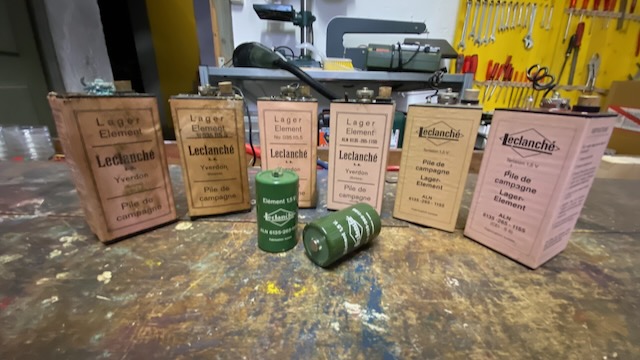
The sound powered "Patrouillen Telefon" from Siemens was only used between 1917 and 1924 and was thus the instrument with the shortest live in the Swiss signal corps [22]. The former was the only strictly sound powered device used in the Swiss Army, but also the single earphone headsets included with every FTf up to the FTf 47 and also the C-Tf and ArtTf had always binding posts on the plugs to be able to connect them directly to a line as lightweight linemen's instrument. For this purpose the first generation instruments had always packed a signalling whistle (reed pipe, german type "Ruftrompete alter Art") in the headset pouch.
For artillery observation there was a specific C-Tf and ATf 32/47 version with headset instead of handset, the "Beobachtertelefon" (based on the C-Tf) and the "Telephon-Postenpackung Modell 1935" (based on the ATf 32) [22].
In the 50ies a Philips developed external signal amplifier for the ATf 32/47 was introduced, the battery powered "Endverstärker 51" (EV-51) which was connected between the handset plug and the handset and supported either RX or TX amplification. Only 400 pieces were acquired and in use up into the 60ies [21]. In the late 60ies the "Armeetelephon 64" (ATf 64) was introduced, a heavy (9kg) desktop LB telephone with included RX/TX amplifier [16]. Historic information about this instrument I have yet to find, probably it was only field tested and never introduced large scale.
In the picture below an ATf 64 with transport box.
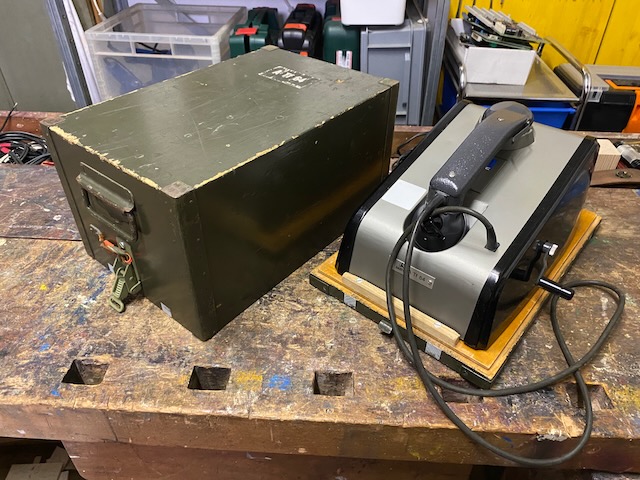
Creative Commons Attribution-ShareAlike 4.0 International License